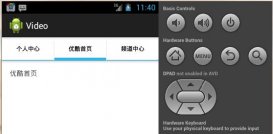前面文章介绍了activity以及intent的使用,本文就来介绍service。如果把activity比喻为前台程序,那么service就是后台程序,service的整个生命周期都只会在后台执行。service跟activity一样也由intent调用。在工程里想要添加一个service,先新建继承service的类,然后到androidmanifest.xml -> application ->application nodes中的service标签中添加。
service要由activity通过startservice 或者 bindservice来启动,intent负责传递参数。
先贴出本文程序运行截图如下:
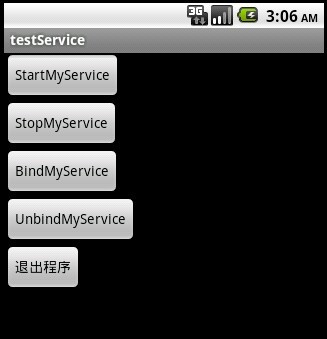
本文主要讲解service的调用,以及其生命周期。
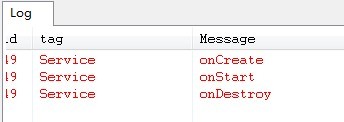
上图是startservice之后再stopservice的service状态变化。
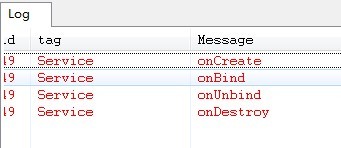
上图是bindservice之后再unbindservice的service状态变化。
startservice与bindservice都可以启动service,那么它们之间有什么区别呢?它们两者的区别就是使service的周期改变。由startservice启动的service必须要有stopservice来结束service,不调用stopservice则会造成activity结束了而service还运行着。bindservice启动的service可以由unbindservice来结束,也可以在activity结束之后(ondestroy)自动结束。
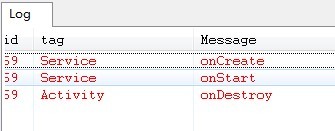
上图是startservice之后再activity.finish()的service状态变化,service还在跑着。
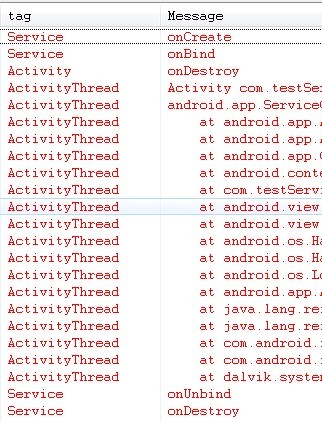
上图是bindservice之后再activity.finish()的service状态变化,service最后自动unbindservice。
main.xml代码如下:
|
1
2
3
4
5
6
7
8
9
10
11
12
13
14
15
16
17
18
19
20
|
<?xml version="1.0" encoding="utf-8"?><linearlayout xmlns:android="http://schemas.android.com/apk/res/android" android:orientation="vertical" android:layout_width="fill_parent" android:layout_height="fill_parent"> <button android:layout_width="wrap_content" android:layout_height="wrap_content" android:id="@+id/btnstartmyservice" android:text="startmyservice"></button> <button android:layout_width="wrap_content" android:layout_height="wrap_content" android:id="@+id/btnstopmyservice" android:text="stopmyservice"></button> <button android:layout_width="wrap_content" android:layout_height="wrap_content" android:id="@+id/btnbindmyservice" android:text="bindmyservice"></button> <button android:layout_width="wrap_content" android:layout_height="wrap_content" android:id="@+id/btnunbindmyservice" android:text="unbindmyservice"></button> <button android:layout_width="wrap_content" android:layout_height="wrap_content" android:id="@+id/btnexit" android:text="退出程序"></button></linearlayout> |
testservice.java的源码如下:
|
1
2
3
4
5
6
7
8
9
10
11
12
13
14
15
16
17
18
19
20
21
22
23
24
25
26
27
28
29
30
31
32
33
34
35
36
37
38
39
40
41
42
43
44
45
46
47
48
49
50
51
52
53
54
55
56
57
58
59
60
61
62
63
64
65
66
67
68
69
70
71
72
73
74
75
76
77
78
79
|
package com.testservice;import android.app.activity;import android.app.service;import android.content.componentname;import android.content.intent;import android.content.serviceconnection;import android.os.bundle;import android.os.ibinder;import android.util.log;import android.view.view;import android.widget.button;public class testservice extends activity { button btnstartmyservice,btnstopmyservice,btnbindmyservice,btnunbindmyservice,btnexit; @override public void oncreate(bundle savedinstancestate) { super.oncreate(savedinstancestate); setcontentview(r.layout.main); btnstartmyservice=(button)this.findviewbyid(r.id.btnstartmyservice); btnstartmyservice.setonclicklistener(new clickevent()); btnstopmyservice=(button)this.findviewbyid(r.id.btnstopmyservice); btnstopmyservice.setonclicklistener(new clickevent()); btnbindmyservice=(button)this.findviewbyid(r.id.btnbindmyservice); btnbindmyservice.setonclicklistener(new clickevent()); btnunbindmyservice=(button)this.findviewbyid(r.id.btnunbindmyservice); btnunbindmyservice.setonclicklistener(new clickevent()); btnexit=(button)this.findviewbyid(r.id.btnexit); btnexit.setonclicklistener(new clickevent()); } @override public void ondestroy() { super.ondestroy(); log.e("activity","ondestroy"); } private serviceconnection _connection = new serviceconnection() { @override public void onserviceconnected(componentname arg0, ibinder arg1) { // todo auto-generated method stub } @override public void onservicedisconnected(componentname name) { // todo auto-generated method stub } }; class clickevent implements view.onclicklistener{ @override public void onclick(view v) { intent intent=new intent(testservice.this,myservice.class); if(v==btnstartmyservice){ testservice.this.startservice(intent); } else if(v==btnstopmyservice){ testservice.this.stopservice(intent); } else if(v==btnbindmyservice){ testservice.this.bindservice(intent, _connection, service.bind_auto_create); } else if(v==btnunbindmyservice){ if(myservice.servicestate=="onbind")//service绑定了之后才能解绑 testservice.this.unbindservice(_connection); } else if(v==btnexit) { testservice.this.finish(); } } }} |
myservice.java的源码如下:
|
1
2
3
4
5
6
7
8
9
10
11
12
13
14
15
16
17
18
19
20
21
22
23
24
25
26
27
28
29
30
31
32
33
34
35
36
37
38
39
40
41
42
43
|
package com.testservice;import android.app.service;import android.content.intent;import android.os.ibinder;import android.util.log;public class myservice extends service { static public string servicestate=""; @override public ibinder onbind(intent arg0) { log.e("service", "onbind"); servicestate="onbind"; return null; } @override public boolean onunbind(intent intent){ super.onunbind(intent); log.e("service", "onunbind"); servicestate="onunbind"; return false; } @override public void oncreate(){ super.oncreate(); log.e("service", "oncreate"); servicestate="oncreate"; } @override public void ondestroy(){ super.ondestroy(); log.e("service", "ondestroy"); servicestate="ondestroy"; } @override public void onstart(intent intent,int startid){ super.onstart(intent, startid); log.e("service", "onstart"); servicestate="onstart"; }} |



